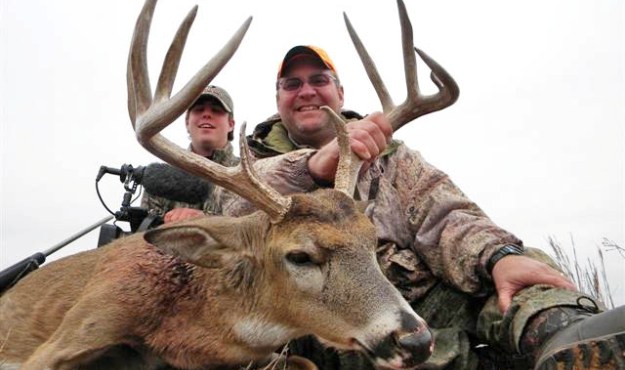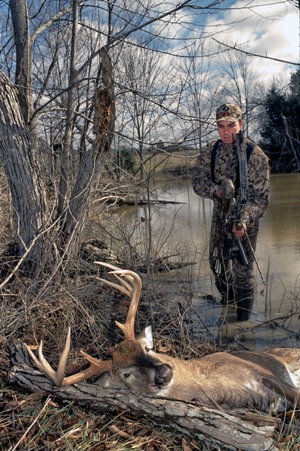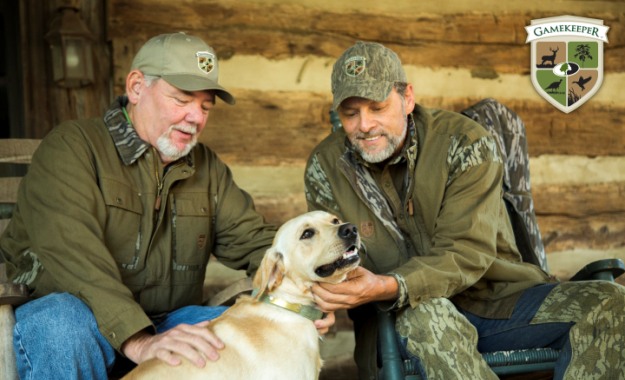
Editor’s Note: Justin Eakins owns Canadian River Hilton Hunting Lodge in Crawford, Oklahoma, on the Canadian River. Justin hunts on 25,000 to 30,000 acres of land and has been one of the co-hosts on Mossy Oak’s “Deer T.H.U.G.S.” TV show for 6 years.
Mossy Oak: how do you get ready for deer season?
Eakins: Preparing for deer season for me and our guides is a 365-day job each year. We scout all-year-long, and we’re always maintaining the lodge, planting food plots, developing better habitat, putting-out trail cameras, checking trail cameras, putting-out feeders, loading the feeders with corn, cutting paths to and from stands, moving stands as wind conditions change and working 16 to 18 hours a day, getting ready for deer season.
 We plant food plots on many of the other properties we hunt. We’ve learned that if we don’t plant fairly-big plots, the deer, the turkeys and the other wildlife will eat-up all the food before deer season arrives. However, we have so much agriculture in the form of wheat fields, corn fields and soybean fields that we don’t have to depend that much on food plots in this area. Our food plots represent a place where deer go to get snack food before and after they eat their main meals in the agricultural fields. Since deer are browsers, they like to eat a wide variety of food. Besides planting Mossy Oak BioLogic where we don’t have a lot of agriculture, we’ll also plant wheat.
We plant food plots on many of the other properties we hunt. We’ve learned that if we don’t plant fairly-big plots, the deer, the turkeys and the other wildlife will eat-up all the food before deer season arrives. However, we have so much agriculture in the form of wheat fields, corn fields and soybean fields that we don’t have to depend that much on food plots in this area. Our food plots represent a place where deer go to get snack food before and after they eat their main meals in the agricultural fields. Since deer are browsers, they like to eat a wide variety of food. Besides planting Mossy Oak BioLogic where we don’t have a lot of agriculture, we’ll also plant wheat.
Although I agree that supplemental feeding is an effective process to having big bucks to take, I also believe that one of the most-important management practices is to let your deer reach the older-age classes. Regardless of how great your deer’s genetics are, if you harvest that buck before he’s mature, you won’t take a buck that’s as big as he will have been if you wait until he’s 4- or 5-years old. If you have some cull bucks that are on your hit list, take the cull buck, and let that nice 3-1/2-year-old buck that’s 10 or 12 points survive for at least another 2 or 3 years. Improving the genetics in your deer herd is not instant pudding. Don’t expect to see the results of culling bucks and improve the genetics of your deer herd within 2 or 3 years. If you’re trying to grow big deer, keeping your doe numbers down and harvesting cull bucks, then you’ll start seeing results. One of the ways that we try and improve the genetics in our deer herd is to allow our guides to help take some of the cull bucks. If you don’t want to spend a deer tag taking a cull buck, then take a family member or one of your hunting buddies and let them harvest a cull buck off your property.
Our section of Oklahoma had an extreme drought in 2011 that wiped out a good portion of our deer herd. We didn’t have as many fawns born as in previous years. When deer numbers are down due to drought and disease, you have a better opportunity to create a successful deer management program than you do when deer numbers are high. We’ve been in a drought situation during 2011-2013 here. In 2011, our wildlife suffered the most. Although we lost a lot of deer, because we only harvested one buck per 1,000 acres, we still had very-successful hunts during those 3 years of droughts
To contact Justin Eakins, call him at 580-497-7500 or email him at hunt@dobsonteleco.com.
Day 1: Hunting Big Oklahoma Deer and Being a Part of the Mossy Oak Family
Tomorrow: Justin Eakins - Stay Away from the Buck Until the Day You Plan to Take Him



























